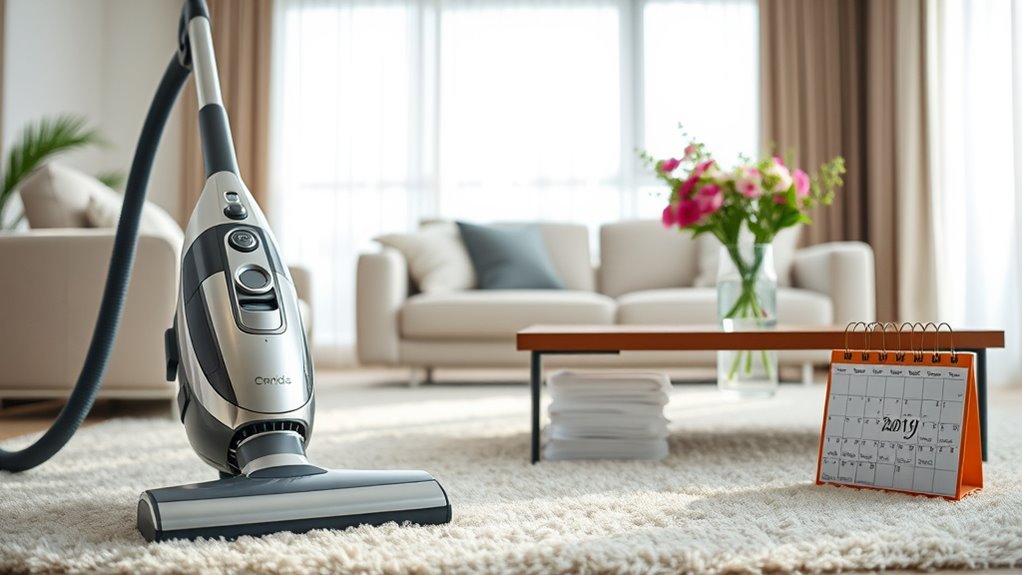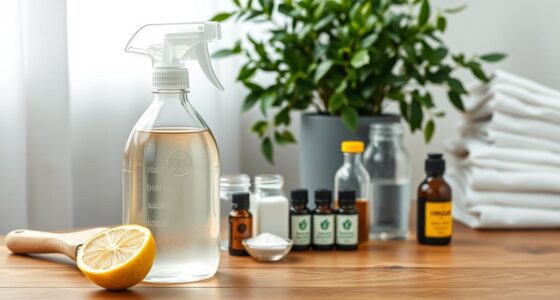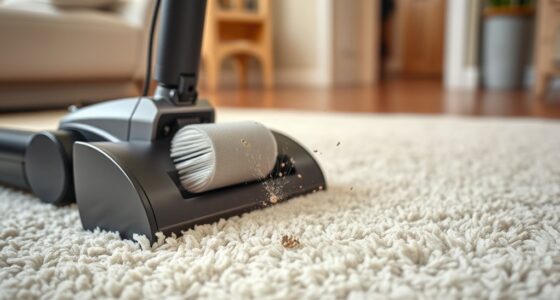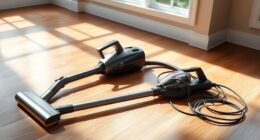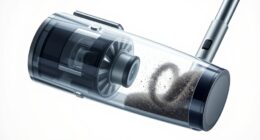To keep your home smelling fresh, handle vacuum odor removal at least once a month by checking and replacing filters, emptying bags or canisters, and cleaning brushes and hoses. In high-traffic or pet owners’ homes, consider doing this every two weeks to prevent odors from building up. Consistently maintaining your vacuum guarantees it runs efficiently and keeps your space free of unwanted smells. Staying on top of this routine helps maintain a clean, fresh environment—you’ll discover more tips as you continue.
Key Takeaways
- Vacuum at least 2-3 times weekly to prevent odor buildup and maintain freshness.
- Increase cleaning frequency in high-traffic or pet areas, possibly daily.
- Check and replace vacuum filters monthly to ensure effective odor control.
- Add baking soda to vacuum bags or canisters during regular cleaning to neutralize smells.
- Conduct thorough cleaning of vacuum components regularly to keep odors from lingering.
Optimizing Your Vacuum Odor Removal Routine
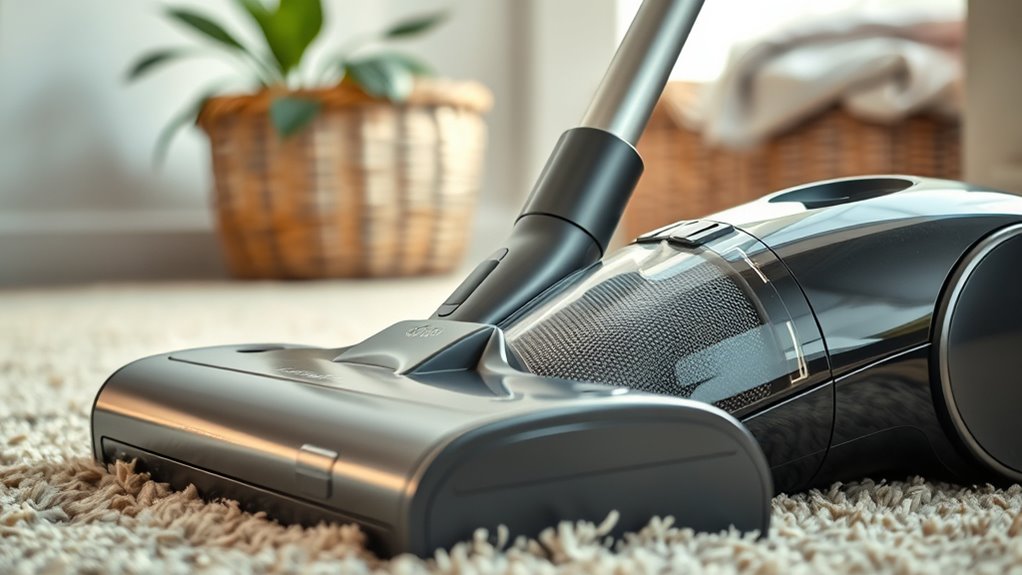
Maintaining a regular vacuum odor removal schedule is vital for keeping your home smelling fresh and clean. When you stay consistent with your vacuuming routines, you prevent odors from lingering and reduce the buildup of dirt and allergens that can contribute to unpleasant smells. One key aspect of this routine is vacuum filter maintenance. Regularly checking and replacing or cleaning your vacuum’s filter ensures it functions efficiently, trapping dust, pet dander, and other odor-causing particles effectively. A clean filter also helps your vacuum perform better, which means improved air quality and less musty smells.
In addition to filter care, paying attention to your carpet cleaning frequency is essential. Carpets act like sponges, absorbing odors from pets, cooking, or even everyday use. How often you should vacuum depends on your household’s activity level, but generally, you should aim for at least twice a week. High-traffic areas may require daily vacuuming to prevent odors from setting in deep within the fibers. If you have pets, consider increasing your cleaning frequency, as pet dander and fur notably contribute to odors. Regular vacuuming keeps these particles at bay, reducing their impact on your home’s scent.
To effectively handle vacuum odor removal, you should also incorporate deodorizing techniques into your routine. Use vacuum bags or canisters with odor-absorbing filters or add baking soda to your vacuum bag or container to neutralize smells as you clean. Remember, a clean vacuum is a smell-free vacuum. If you notice a musty or foul odor emanating from your vacuum, it’s a sign to check the filter and bags, replace filters if necessary, and clean any debris from the brushes and hoses. Additionally, understanding vacuum filter maintenance can help you prolong the life and effectiveness of your vacuum’s odor control.
Creating a practical schedule involves balancing these factors. For most households, vacuuming two to three times a week combined with weekly or biweekly carpet cleaning suffices to keep odors in check. If you have pets or allergy sufferers, increase the frequency accordingly. Don’t forget to check your vacuum’s filter monthly, replacing or cleaning it as recommended by the manufacturer. This simple step guarantees your vacuum continues to trap odor-causing particles effectively.
Sticking to this schedule not only maintains the cleanliness of your carpets but also helps prevent odors from building up over time. By consistently maintaining your vacuum filter and adjusting your carpet cleaning frequency based on your household’s needs, you’ll enjoy a fresher, more inviting home every day.
Frequently Asked Questions
Can Vacuum Odor Removal Be Done Daily Without Damaging the Vacuum?
Yes, you can do vacuum odor removal daily without damaging your vacuum. Regular vacuum maintenance, like emptying the bin and cleaning filters, helps prevent odors and keeps your vacuum working efficiently. Daily odor prevention involves using odor-neutralizing products or baking soda, but avoid overusing harsh chemicals. Consistent upkeep guarantees your vacuum stays fresh and functional, preventing odor buildup while protecting its longevity.
What Signs Indicate My Vacuum Needs Odor Treatment More Frequently?
You should treat your vacuum for odors more often if you notice persistent smells despite regular filter maintenance. Unpleasant odors may also indicate that storage conditions are too damp or poorly ventilated, trapping moisture and bacteria. If your vacuum emits strong or stale smells after cleaning, it’s a sign to increase odor removal frequency, ensuring filters are clean and storage areas are dry and well-ventilated to prevent odor buildup.
Are There Specific Vacuum Models Better for Odor Removal?
When it comes to vacuum models, look for those with excellent air filtration, like HEPA filters—they’re worth their weight in gold for odor removal. These vacuums trap tiny particles and allergens, making your space smell fresher. Brands like Dyson and Shark often feature models with advanced filtration systems, giving you peace of mind. Remember, a vacuum is only as good as its filter system, so pick wisely to keep odors at bay.
How Do I Prevent Odor Buildup in My Vacuum Over Time?
To prevent odor buildup in your vacuum, regularly clean the filters and empty the canister or replace the bag. Incorporate air purifier maintenance into your routine to help freshen the air. Follow a consistent filter replacement schedule—usually every 3 to 6 months—to prevent odors from lingering. Additionally, wipe down the vacuum’s interior and brushes to remove trapped debris and prevent unpleasant smells from developing over time.
Does Vacuum Type (Upright, Canister) Affect Odor Management Frequency?
Yes, your vacuum type affects odor management frequency. Upright vacuums often trap more debris, requiring more frequent vacuum maintenance to prevent odors. Canister vacuums typically have better airflow and easier cleaning, so odor prevention can be less frequent. Regardless of type, regular emptying, cleaning filters, and checking for debris help control odors effectively. Adjust your vacuum maintenance routine based on your vacuum’s design to keep odors at bay and guarantee peak performance.
Conclusion
By sticking to a regular schedule, you turn your vacuum into a fresh-air guardian, banishing odors before they settle in. Think of it as tending a garden—consistent care keeps everything blooming and fragrant. Handle your vacuum odor removal like a rhythmic dance, moving smoothly and confidently. With each routine, you cultivate a cleaner, more inviting home, where fresh scents swirl like a gentle breeze. Keep the rhythm, and let your space breathe freely and beautifully.
